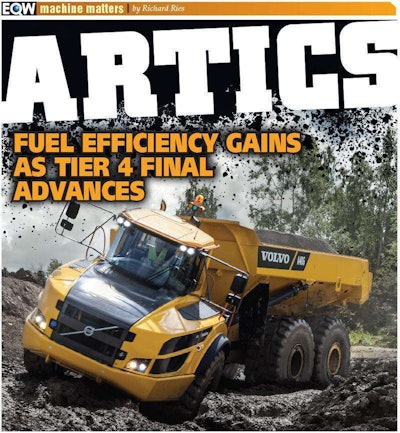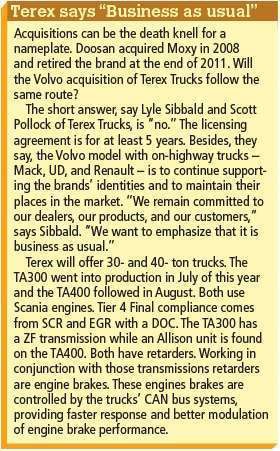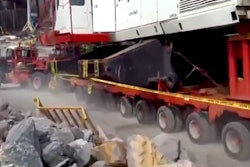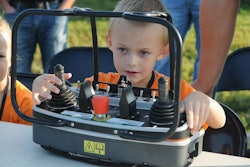
Much of the new is related to the requirement to meet Tier 4 Final emissions standards. New engines. New aftertreatment systems. But this is emissions compliance, after all, and it’s hard to see where there’s a real impact on business. Thankfully, manufacturers have worked hard to bring benefits to the customer while also meeting Tier 4 Final regulations; virtually all of them report fuel savings as part of that benefits package.
Henrik Larsson, product manager with Volvo, says overall fuel use is 4 to 5 percent better with Volvo Tier 4 Final models than with their Tier 4 Interim predecessors. These days manufacturers are left looking for small gains in fuel efficiency, “a half-percent here, a half-percent there,” says Larsson. Much of what Volvo accomplished came from extended passive regeneration intervals of the aftertreatment system on the A35G and A40G models since active regeneration consumes fuel. While daily regeneration was common on Tier 4 Interim haulers, regen intervals now often extend to 500 hours and beyond. The 13-liter engines in the A25G and A30G trucks rely on SCR for aftertreatment and therefore require no regeneration.
Both Caterpillar and Volvo offer a fuel efficiency guarantee. If a customer uses more fuel than Volvo says they will, Volvo writes that customer a check. The numbers used for the basis of the guarantee are quite low, lower even than the numbers published in Volvo’s performance handbook. (Restrictions apply. Learn more at www.VolvoCE.com > Products > Fuel efficiency.) Caterpillar is also reporting fuel efficiency increases of up to 5 percent and details on its fuel efficiency guarantee are available through its dealers.
Doosan says the new DA40 offers 8 percent better fuel efficiency than the MT41 it replaces. In their testing the DA40 consumed 4.5 gallons per hour. Some of that efficiency comes from a new ZF 8-speed transmission, which replaces the 6-speed transmission in the previous truck. The transmission and a revised gear ratio in the differential allow the Scania DC 13 engine to run at a lower speed for a given travel speed while preserving performance. The engine has 11 percent more horsepower and 28 percent more torque than the engine in the MT41 and payload has been increased more than 15 percent from the MT41 to the DA40.
When size doesn’t matter
Looking again at the Spec Guides it’s easy to see a steady march toward bigger trucks. In 2008 there were 10 models of 26 metric tons or less; by 2014 that had dwindled to just one, Deere’s 23.2-
In general the rule is that cost per ton comes down as size goes up. This means that an operation should always buy the biggest machines that it can run effectively. “But these considerations add complexity to what otherwise seems to be a very simple rule of thumb,” says Neville Paynter, president of Bell Trucks America. (See “Which size is best?” sidebar on page 33).
Fortunately customers don’t have to move up to a bigger truck to get desirable features as most features tend to be equally spread among all trucks, regardless of size. Caterpillar’s Automatic Traction Control (ATC) system was introduced on 735B and 740B models in 2011 and has now migrated down as standard equipment on the smaller 730C.
This includes service features. For example, all E-Series John Deere ADTs have ground-level service. Grease fittings have been reduced to just eight, and they need to be accessed every 50 hours instead of every 8 hours, as was common in the past. Doosan’s ADTs feature fully automated central greasing systems. And G-Series Volvo articulated trucks have their hydraulic tanks, fuse panels, batteries, aftertreatment systems, mufflers, fuel tanks and refueling pipes moved to new positions. This was done in part to accommodate new hardware associated with Tier 4 Final, but the locations are more intuitive and facilitate servicing. Comfort and convenience features for operators have become standard across all sizes.
Some differentiation based on size remains. “Although all tonnage sizes of articulated trucks are found in all industry segments, from mining and heavy construction to waste and general construction, the larger machines are sold in a higher proportion into mining and heavy construction,” says Anthony Pollock of Caterpillar. While those larger trucks are designed with productivity as a key consideration, smaller trucks focus more on controlling total cost of ownership, an essential consideration in the rental market. Caterpillar’s 725C, for example, features an integral front bumper and full belly pan to help control repair costs.
Compensation
While operators of motor graders, excavators and other equipment often receive extensive training, many behind the wheel of an articulated dump truck do not. Many of the features on an ADT are intended to compensate for this lack of training and can improve productivity even with well-trained, highly-experienced operators. Two examples of this are traction control and auto-dump.

Caterpillar’s ATC proportionately engages the axle clutches as required to provide torque to the wheels that are able to provide traction. Wheel speed sensors monitor slip and signal the clutch to adjust engagement as wheels pass through areas of varying traction. The system will adjust the clutch engagement up to 100 percent locking in the worst underfoot conditions. The Cat ATC system is also integrated with the machine’s steering system to improve steering response and stop “crabbing” in turns. The system is fully automatic, requiring no input from the operator.
While some traction controls systems, such as Caterpillar’s, are fully automatic, others are automatic with a manual override and yet others have modes that must be engaged by the operator. Deere’s version has an inter-axle (front-to-rear) differential lock plus a cross-axle (side-to-side) diff lock. The two can be used independently or in unison, set to automatic or engaged via a foot switch, and the inter-axle lock engages automatically in reverse to improve efficiency when backing uphill.
Auto-dump is mostly standardized across brands. The operator positions the truck and pushes a button. The system sets the brakes, increases engine speed, and runs through the dump cycle. Some OEMs add tweaks to the system. Bell’s I Tip, for example, slows engine speed and cylinder stroke at the top of the bin tip to keep the cylinder from topping out hard and making the whole truck jump. Others put limiters on the dump body to reduce tip-over risk when dumping downhill and to avoid overhead obstructions. Caterpillar offers two ejector models, the 730C EJ and 740B EJ, that eliminate risk from overhead strikes and also assist with spreading material.
Other features are designed to be especially helpful to less-experienced operators. Backup cameras have become commonplace; Deere offers a second rear-facing camera on the A-pillar so an operator can see when the dump is complete, thereby minimizing carry-back.
Hill assist maintains downhill speeds. Once the ADT achieves the desired speed, the operator engages the system and electronics take over. Bell offers hill-start assist, as well. When starting out on an upslope the machine measures the slope and waits until the operator has depressed the accelerator enough so that the engine produces enough torque to be able to drive up the hill. At that point the park brake is released and the machine pulls away.
There’s much that’s new about these new trucks. Compared to the listings in the 2008 Spec Guide, the number of models may be down but the levels of innovation and value are clearly up.











